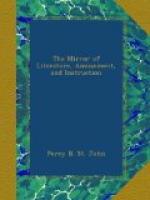The shades of evening now began to add to the solemnity of the scene, by the indistinctness that was gradually enveloping the more distant objects; and, alone, we almost dreaded to break, with our own whispers, the silence which reigned around. In the midst of this “stillness audible,” the fine bell of the cathedral struck the hour, and its melodious tone seemed at once to reach the heart. We sat down to listen to the prolonged note, as each successive toll reverberated through the expanse—lingering like a halo around the walls, and appearing to awaken echoes from the guardian spirits of the night. I fancied I had never in my life heard so full-toned—so musical a bell: certain it is, none ever gave me the same sensation of delight. Indeed, the whole belfry is well assorted, for the carillons, which play certain airs at intervals, produce a sweeter effect than I remember any where else; and one of the pleasant recollections I retain of Antwerp arises out of the frequent, but unobtrusive, chimes that salute the ear during the day. We left Notre Dame this time with “lingering steps and slow.”
But how can I give an idea of the exterior? The tendency to placid reflection which we had caught within found ample food for indulgence when we came to witness the effect of the architecture without, combined with the particular time of night—about nine o’clock—different tints and shadows displaying themselves upon the angles of the building, as the light decreased. Imagine a spire of light, ornamental, elegant open-work, carried up about a hundred feet higher than St. Paul’s. I believe it is the loftiest in Europe, with the exception of Strasbourg, than which, in the opinion of many, it is more handsome. The only drawback upon its beauty is the glaringly large dial of the clock; but even this may suggest appropriate reflection: for may we not consider it an emblem of Time, whose course it measures, intruding upon the fairest prospects of our lives, to remind us that all human monuments and enjoyments must yield to his irresistible hand? The spire rises on one side of the principal entrance; and there is a corresponding tower on the other, to the height of the base of the steeple part, as if there had been an intention to erect one of similar dimensions there also, like the twin towers of Westminster Abbey; but I cannot help thinking, that as two and two are said not always to make four, the projecting counterpart, instead of doubling the effect, would have lessened the feeling of stupendous height with




